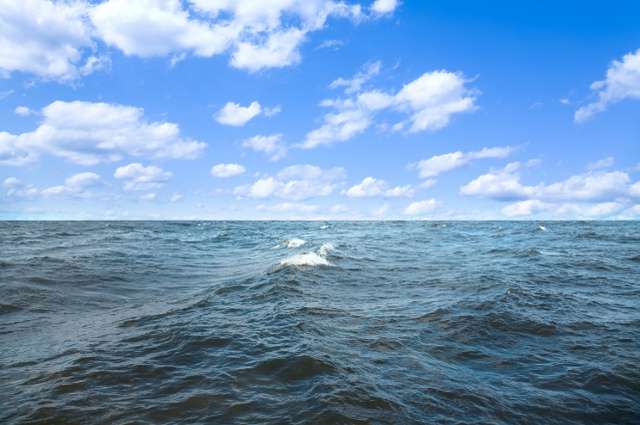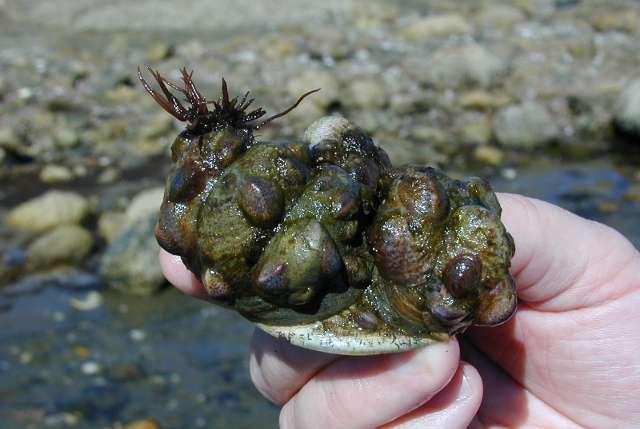Biologist studies how the increasing acidity that has come with climate change is affecting ocean life

The increasing acidity of the world's oceans is having some pretty dire effects, including damaging coral reefs and weakening the shells of clams, oysters and mussels. Acidification is also harming sea creatures at the bottom of the oceanic food chain, such as plankton and fish larvae, posing a threat to many species of marine life.
Delving more deeply into the decrease in the pH of the world's oceans, Jan Pechenik, a professor of biology in the School of Arts and Sciences, is tracking its ramifications for a common marine snail, Crepidula fornicata, also known as the slipper snail, a species that's found along both U.S. coasts and has now invaded the coastlines of Europe.
Working for the next three summers at the Friday Harbor Laboratories at the University of Washington on Puget Sound, he will also investigate other stressors that could affect the snails' development, such as rising seawater temperatures and the availability of food. His work is being supported by a three-year, $315,000 National Science Foundation grant.
Pechenik talked with Tufts Now about the causes and consequences of ocean acidification, what this portends for the future of the oceans and how a common snail may help provide some of the answers.
Tufts Now: What is ocean acidification?
Jan Pechenik: Basically, the concentration of hydrogen ions in seawater is increasing. Since the start of the Industrial Revolution about 250 years ago, the hydrogen ion concentration in seawater has increased by something like 30 percent. There is no controversy about that—chemists have been making those sorts of measurements for a very long time. And the ocean is now projected to keep becoming more acidic for at least the next 100 years.
Do we know what is causing acidification?
The only explanation anyone has proposed is that the ocean has been absorbing more carbon dioxide from the air. If you dissolve carbon dioxide in water, you get carbonic acid, just like in Coke and Pepsi. The carbonic acid breaks apart in the seawater and releases hydrogen ions, which cause higher acidity.
Trucks, cars, power plants and the cement we use in construction—all that releases a lot of CO2 into the air. Scientists have estimated the ocean has absorbed about one third of that excess carbon dioxide.
There are a lot of data showing that the carbon dioxide levels in the atmosphere are higher now than they have been in the last 150,000 years.
Where is this occurring?

We are talking about all the world's oceans—all of them—becoming more acidic. We have produced so much extra carbon dioxide in the atmosphere in the past 250 years or so that we have actually managed to make the world's oceans more acidic. That is a lot of water. This is one of the most fantastic things I've heard in my life.
What is the effect of ocean acidification?
That's the big question, and we need to do more studies to find out. But we do know that animals that make shells and other calcium carbonate homes, like corals, oysters, clams and mussels, are probably going to suffer, because calcium carbonate dissolves in more acidic conditions. Studies show that lower pH often causes these organisms to calcify much less than they would normally—that is, they build weaker shells, or they build them more slowly, or both.
Clams, mussels, oysters and other marine mollusks are microscopic in their developmental stages, typically hatching at less than 100 microns as larvae, less than the width of a human hair, and they have very thin shells. Under more acidic conditions, they are likely to be even more vulnerable to predators, like krill and jellyfish, and suspension feeders like bivalves and even adult Crepidula fornicata.
Other bivalves react to increased acidity by putting more energy into making strong shells, but that means they have less energy for other things like overall development, so they grow much more slowly. So either way, they will be more vulnerable to predators, and may mature at smaller sizes and produce fewer eggs.
What other effects from ocean acidity have been observed?
Some are really surprising, things I would never have expected to see. A study from a few years ago on the larvae of a coral reef fish showed that when you increase the acidity of the seawater, the larvae lose the ability to detect the scent of predators, and in fact, a lot of them swim toward the predator. That is probably due to a change in the functioning of their sensory receptors, but no one yet knows how that mechanism works.
Some of the consequences can be really subtle. Recent studies show that acidification causes a shift in the chemical composition of single-celled algae called phytoplankton, making them less nutritious for the species that eat them. Those single-cell algae are major food sources for the larvae of clams, mussels and oysters and a whole variety of other organisms, including my snails.
Why does that matter?
I recently did laboratory research feeding three different algal species with different nutritional values to the larvae of the marine snail I am working with for this NSF study. I found that the larvae raised on the poorer algal diets all grew more slowly as juveniles, their next stage of development, even though they were given the best diet once they entered the juvenile stage.
If we find that also happening in the ocean, it means the snails are going to be more vulnerable to predators for a longer time—both as larvae and juveniles. Fewer snails mean fewer larvae that many marine animals depend on for food, and fewer larvae to make the next generation of adults.
But the ocean is not just getting more acidic, it is also getting warmer. This will change species' ranges so organisms are going to be coming into contact with animals and plants they've never encountered before; we don't know the consequences of these altered interactions. There are also the consequences of pollution to consider, and changes in ocean salinity due to altered rainfall patterns resulting from climate change. That's what I mean when I say the consequences are going to be really hard to predict, including what sea animals will be affected.
Why is the marine snail Crepidula fornicata such an ideal research subject?
It is native to the East Coast, from Nova Scotia to maybe as far south as Florida. But it is also a major invasive species—it is also on the West Coast, where I will be working, and it is spreading around the world. In the future it may be useful for monitoring the effects of global climate change and ocean acidification. The snails are easy to collect—they just sit in stacks in rocky shore areas. I wait for low tide. I go out and pick them up, put them in my bucket and take them to the lab.
Each time an individual reproduces, thousands of larvae are released, making it easy to achieve good sample sizes. They are also very easy to keep in the lab: I can raise the animals with essentially no mortality, from larvae all the way to adulthood. Also, many developmental and physiological studies have already been conducted with this species, so we're working with an animal about which quite a bit is already known.
What happens in the lab?
I have previously shown that the juveniles of this species grow more slowly if they have experienced certain environmental stresses earlier in development, as embryos or larvae, but no one has yet looked at how this is being caused: how does being stressed as an embryo or larva end up changing how fast they grow, whether they survive after metamorphosis, or how many offspring they have later?
My graduate student Robert Burns and I hope to understand the molecular basis for how these effects are caused by the combination of acidity, heat and nutritional stress. Crepidula may eventually become a model for understanding the "latent" effects of stress during fetal development of other species, including humans, in a changing climate.
Provided by Tufts University





















